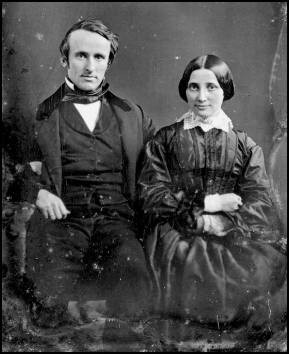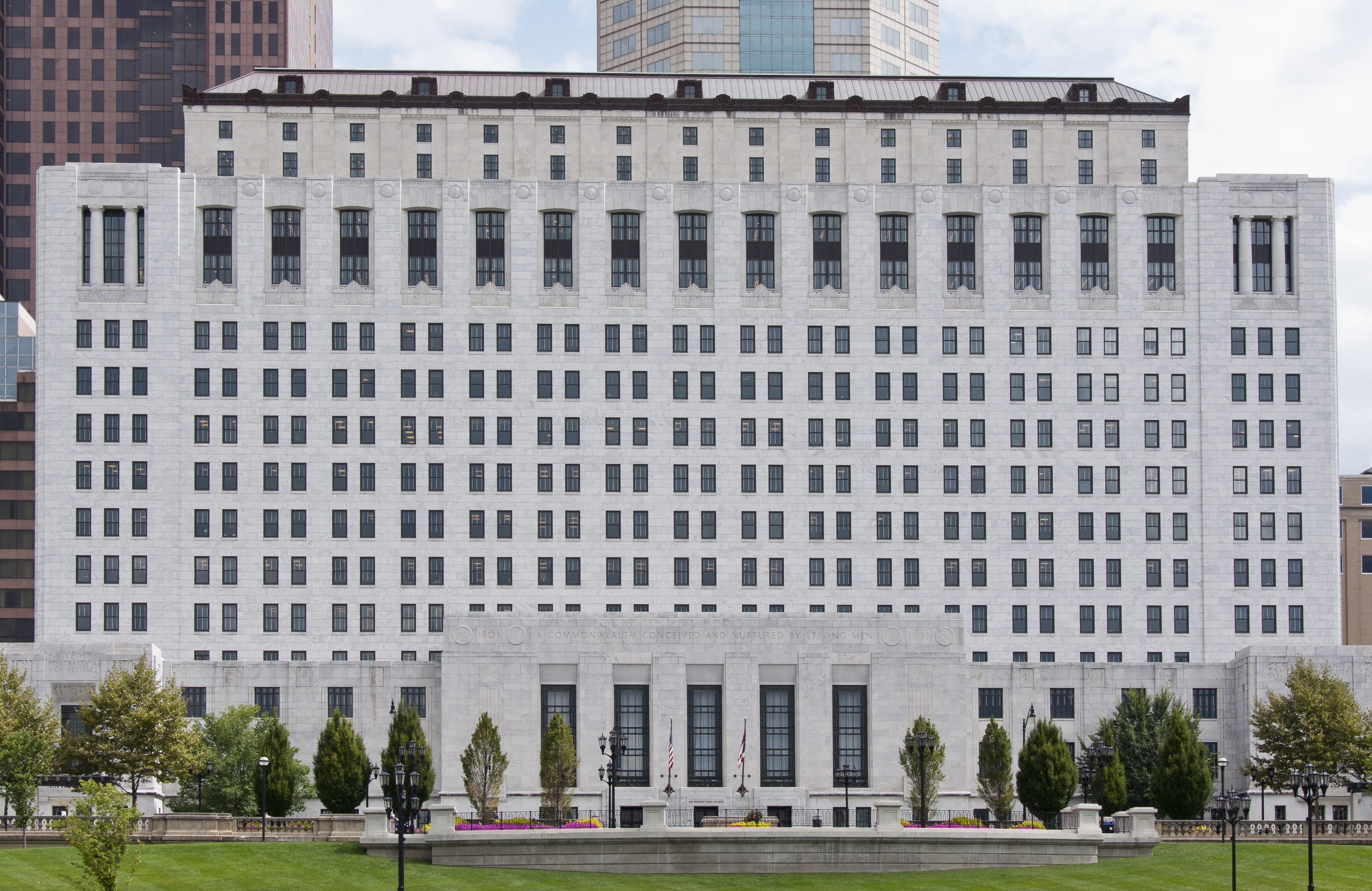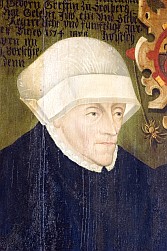|
Lucy Webb Hayes
Lucy Ware Hayes ( née Webb; August 28, 1831 – June 25, 1889) was the wife of President Rutherford B. Hayes and served as first lady of the United States from 1877 to 1881. Hayes was the first First Lady to have a college degree. She was also a more egalitarian hostess than previous First Ladies. An advocate for African Americans both before and after the American Civil War, Lucy invited the first African-American professional musician to appear at the White House. She was a Past Grand of Lincoln Rebekah Lodge of the Independent Order of Odd Fellows, together with her husband. Historians have christened her "Lemonade Lucy" due to her staunch support of the temperance movement; however, contrary to popular belief, she was never referred to by that nickname while living. It was her husband who banned alcohol from the White House. Early life Lucy Webb was born on August 28, 1831 in Chillicothe, Ohio. Her parents were Dr. James Webb and Maria Cook. She had two older broth ... [...More Info...] [...Related Items...] OR: [Wikipedia] [Google] [Baidu] |
First Lady Of The United States
The first lady of the United States (FLOTUS) is the title held by the hostess of the White House, usually the wife of the president of the United States, concurrent with the president's term in office. Although the first lady's role has never been codified or officially defined, she figures prominently in the political and social life of the United States. Since the early 20th century, the first lady has been assisted by official staff, now known as the Office of the First Lady and headquartered in the East Wing of the White House. Jill Biden is the current first lady of the United States, as wife of the 46th and current president of the United States, Joe Biden. While the title was not in general use until much later, Martha Washington, the wife of George Washington, the first U.S. president (1789–1797), is considered to be the inaugural first lady of the United States. During her lifetime, she was often referred to as "Lady Washington". Since the 1790s, the role of fir ... [...More Info...] [...Related Items...] OR: [Wikipedia] [Google] [Baidu] |
Temperance Movement
The temperance movement is a social movement promoting temperance or complete abstinence from consumption of alcoholic beverages. Participants in the movement typically criticize alcohol intoxication or promote teetotalism, and its leaders emphasize alcohol's negative effects on people's health, personalities and family lives. Typically the movement promotes alcohol education and it also demands the passage of new laws against the sale of alcohol, either regulations on the availability of alcohol, or the complete prohibition of it. During the 19th and early 20th centuries, the temperance movement became prominent in many countries, particularly in English-speaking, Scandinavian, and majority Protestant ones, and it eventually led to national prohibitions in Canada (1918 to 1920), Norway (spirits only from 1919 to 1926), Finland (1919 to 1932), and the United States (1920 to 1933), as well as provincial prohibition in India (1948 to present). A number of temperance organiza ... [...More Info...] [...Related Items...] OR: [Wikipedia] [Google] [Baidu] |
Fugitive Slaves In The United States
In the United States, fugitive slaves or runaway slaves were terms used in the 18th and 19th century to describe people who fled slavery. The term also refers to the federal Fugitive Slave Acts of 1793 and 1850. Such people are also called freedom seekers to avoid implying that the slave had committed a crime and that the slaveholder was the injured party. Generally, they tried to reach states or territories where slavery was banned, including Canada, or, until 1821, Spanish Florida. Most slave law tried to control slave travel by requiring them to carry official passes if traveling without a master. Passage of the Fugitive Slave Act of 1850 increased penalties against runaway slaves and those who aided them. Because of this, some freedom seekers left the United States altogether, traveling to Canada or Mexico. Approximately 100,000 American slaves escaped to freedom. Laws Beginning in 1643, the slave laws were enacted in Colonial America, initially among the New England Co ... [...More Info...] [...Related Items...] OR: [Wikipedia] [Google] [Baidu] |
Lucy Stone
Lucy Stone (August 13, 1818 – October 18, 1893) was an American orator, abolitionist and suffragist who was a vocal advocate for and organizer promoting rights for women. In 1847, Stone became the first woman from Massachusetts to earn a college degree. She spoke out for women's rights and against slavery. Stone was known for using her birth name after marriage, contrary to the custom of women taking their husband's surname. Stone's organizational activities for the cause of women's rights yielded tangible gains in the difficult political environment of the 19th century. Stone helped initiate the first National Women's Rights Convention in Worcester, Massachusetts and she supported and sustained it annually, along with a number of other local, state and regional activist conventions. Stone spoke in front of a number of legislative bodies to promote laws giving more rights to women. She assisted in establishing the Woman's National Loyal League to help pass the Thirteenth Amen ... [...More Info...] [...Related Items...] OR: [Wikipedia] [Google] [Baidu] |
Supreme Court Of Ohio
The Ohio Supreme Court, Officially known as The Supreme Court of the State of Ohio is the highest court in the U.S. state of Ohio, with final authority over interpretations of Ohio law and the Ohio Constitution. The court has seven members, a chief justice and six associate justices, who are elected at large by the voters of Ohio for six-year terms. The court has a total of 1,550 other employees. Since 2004, the court has met in the Thomas J. Moyer Ohio Judicial Center (formerly known as the Ohio Departments Building) on the east bank of the Scioto River in Downtown Columbus. Prior to 2004, the court met in the James A. Rhodes State Office Tower and earlier in the Judiciary Annex (now the Senate Building) of the Ohio Statehouse. The Ohio Supreme Court and the rest of the judiciary is established and authorized within Article IV of the Ohio Constitution. Justices All the seats on the court are elected at large by the voters of Ohio. Every two years, two of the associate ... [...More Info...] [...Related Items...] OR: [Wikipedia] [Google] [Baidu] |
Columbus, Ohio
Columbus () is the state capital and the most populous city in the U.S. state of Ohio. With a 2020 census population of 905,748, it is the 14th-most populous city in the U.S., the second-most populous city in the Midwest, after Chicago, and the third-most populous state capital. Columbus is the county seat of Franklin County; it also extends into Delaware and Fairfield counties. It is the core city of the Columbus metropolitan area, which encompasses 10 counties in central Ohio. The metropolitan area had a population of 2,138,926 in 2020, making it the largest entirely in Ohio and 32nd-largest in the U.S. Columbus originated as numerous Native American settlements on the banks of the Scioto River. Franklinton, now a city neighborhood, was the first European settlement, laid out in 1797. The city was founded in 1812 at the confluence of the Scioto and Olentangy rivers, and laid out to become the state capital. The city was named for Italian explorer Christopher Columbus. ... [...More Info...] [...Related Items...] OR: [Wikipedia] [Google] [Baidu] |
Cincinnati
Cincinnati ( ) is a city in the U.S. state of Ohio and the county seat of Hamilton County. Settled in 1788, the city is located at the northern side of the confluence of the Licking and Ohio rivers, the latter of which marks the state line with Kentucky. The city is the economic and cultural hub of the Cincinnati metropolitan area. With an estimated population of 2,256,884, it is Ohio's largest metropolitan area and the nation's 30th-largest, and with a city population of 309,317, Cincinnati is the third-largest city in Ohio and 64th in the United States. Throughout much of the 19th century, it was among the top 10 U.S. cities by population, surpassed only by New Orleans and the older, established settlements of the United States eastern seaboard, as well as being the sixth-most populous city from 1840 until 1860. As a rivertown crossroads at the junction of the North, South, East, and West, Cincinnati developed with fewer immigrants and less influence from Europe than Ea ... [...More Info...] [...Related Items...] OR: [Wikipedia] [Google] [Baidu] |
Women's Suffrage
Women's suffrage is the right of women to vote in elections. Beginning in the start of the 18th century, some people sought to change voting laws to allow women to vote. Liberal political parties would go on to grant women the right to vote, increasing the number of those parties' potential constituencies. National and international organizations formed to coordinate efforts towards women voting, especially the International Woman Suffrage Alliance (founded in 1904 in Berlin, Germany). Many instances occurred in recent centuries where women were selectively given, then stripped of, the right to vote. The first place in the world to award and maintain women's suffrage was New Jersey in 1776 (though in 1807 this was reverted so that only white men could vote). The first province to ''continuously'' allow women to vote was Pitcairn Islands in 1838, and the first sovereign nation was Norway in 1913, as the Kingdom of Hawai'i, which originally had universal suffrage in 1840, r ... [...More Info...] [...Related Items...] OR: [Wikipedia] [Google] [Baidu] |
Ohio Wesleyan University
Ohio Wesleyan University (OWU) is a private liberal arts college in Delaware, Ohio. It was founded in 1842 by methodist leaders and Central Ohio residents as a nonsectarian institution, and is a member of the Ohio Five – a consortium of Ohio liberal arts colleges. Ohio Wesleyan has always admitted students irrespective of religion or race and maintained that the university "is forever to be conducted on the most liberal principles."Alexander, William M. "Ohio Wesleyan University". ''Peabody Journal of Education'', Vol. 38, No. 4 (Jan. 1961), pp. 200–203. The site is 27 miles (44 km) north of Columbus, Ohio. It includes the main academic and residential campus, the Perkins Observatory, and the Kraus Wilderness Preserve. History Founding (1841–1855) In 1841, Ohio residents Adam Poe and Charles Elliott decided to establish a university "of the highest order" in central Ohio. To that end, they purchased the Mansion House Hotel, a former health re ... [...More Info...] [...Related Items...] OR: [Wikipedia] [Google] [Baidu] |
Delaware, Ohio
Delaware is a city in and the county seat of Delaware County, Ohio, United States. Delaware was founded in 1808 and was incorporated in 1816. It is located near the center of Ohio, is about north of Columbus, and is part of the Columbus, Ohio metropolitan area. The population was 41,302 at the 2020 census, while the Columbus metropolitan area has 2,002,604 people. History While the city and county of Delaware are named for the Delaware tribe, the city of Delaware itself was founded on a Mingo village called Pluggy's Town. The first recorded settler was Joseph Barber in 1807. Shortly afterward, other men started settling in the area (according to the Delaware Historical Society); namely: Moses Byxbe, William Little, Solomon Smith, Elder Jacob Drake, Thomas Butler, and Ira Carpenter. In 1808, Moses Byxbe built the first framed house on William Street. Born in Delaware County in 1808, Charles Sweetser went on to become a member of the United States House of Representatives fro ... [...More Info...] [...Related Items...] OR: [Wikipedia] [Google] [Baidu] |







